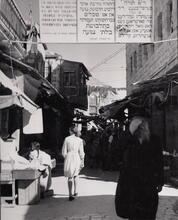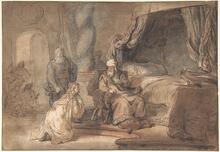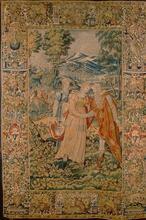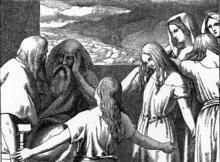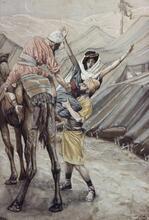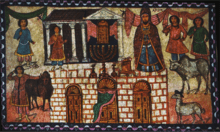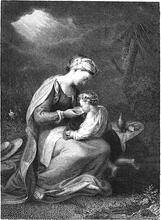Concubine of a Levite: Midrash and Aggadah
The story of the concubine at Gibeah is one of the most shocking narratives in the Bible. The unnamed concubine flees the home of an unnamed Levite, who travels to reclaim her from her father. When a crowd of Benjamites comes to rape the Levite, he sends her out in his stead and she is murdered, triggering a brutal civil war among the Israelites. The rabbis do not blame the unnamed woman for her fate and the ensuing crisis, instead placing the blame at the feet of the Levite for his selfishness and the leaders of Israel for their lax leadership.
Remembering Gibeah
The story of the concubine at Gibeah is one of the most shocking narratives in the Bible. The (Aramaic) A work containing a collection of tanna'itic beraitot, organized into a series of tractates each of which parallels a tractate of the Mishnah.Tosefta attests that these verses are read in public, along with their Aramaic targum, that is, they are interpreted during the public reading of the Torah she-bi-khetav: Lit. "the written Torah." The Bible; the Pentateuch; Tanakh (the Pentateuch, Prophets and Hagiographia)Torah (Tosefta Lit. "scroll." Designation of the five scrolls of the Bible (Ruth, Song of Songs, Lamentations, Ecclesiastes, Esther). The Scroll of Esther is read on Purim from a parchment scroll.Megillah 3:33). The Lit. "teaching," "study," or "learning." A compilation of the commentary and discussions of the amora'im on the Mishnah. When not specified, "Talmud" refers to the Babylonian Talmud.Talmud explains that although a matter that publicly tarnishes the honor of the tribe of Benjamin should not properly be aired, the tribe’s reputation is not a consideration in this case (BT Megillah 25b). The Tosefta and the Talmud apparently find educational value in this narrative, and feel that something important is to be learned even from such a troubling occurrence.
The A type of non-halakhic literary activitiy of the Rabbis for interpreting non-legal material according to special principles of interpretation (hermeneutical rules).midrash relates to the concubine sympathetically and positively, while the Rabbis direct their criticism at her husband and at the people of his generation. The story begins with the concubine of a Levite who left him and returned to her father’s house. Judges 19:2 relates: “Once his concubine played the harlot with him, leaving him for her father’s house.” The Rabbis understand this not as promiscuous activity on her part; rather, she fled to her father’s house because her husband was angry with her. Two Rabbis disagree concerning the cause of his ire. R. Ebiathar says he found a fly in a dish that she cooked for him, and R. Yonatan argues that he found a hair there (BT Writ of (religious) divorceGittin 6b). This disagreement, which was intended to find fault with the Levite, stresses his improper behavior toward his concubine, even before the events that took place in Gibeah of Benjamin. This depiction explains why his father-in-law (the concubine’s father) feared to return his daughter to her spouse, and why he postponed their departure from his home time after time, trying with all his might to persuade them to remain (Jud. 19:4–9). The rabbinical exposition teaches that the Levite preferred his personal benefit (the proper dish) to his spouse’s welfare and their relationship. This behavior precedes the scene at Gibeah in which the man sends his concubine to the crowd (and eventually, to her death) in order to save himself, resulting in a civil war among the Israelites.
These and These are the Words of the Living God
The Talmud relates that after the two Rabbis disagreed on this point, R. Ebiathar encountered Elijah. R. Ebiathar asked the prophet: “What is God doing?” Elijah replied: “He is occupied now with the matter of the concubine at Gibeah.” R. Ebiathar continued to ask: “And what is He saying?” Elijah answered: “Thus says God: My son Ebiathar says such-and such, and My son Yonatan says such-and-such.” R. Ebiathar exclaimed: “Heaven forbid! Can there be any doubt before God [does God not know what happened, that he mentions the two differing views]?” Elijah told him: “Both are the word of the living God” (BT Gittin 6b). This midrash stresses the tolerance to be shown to the view of another Torah scholar, even when disagreeing with him. The phrase “Both are the word of the living God” usually means that there is truth in each of the dissenting views, and that each reflects something of the divine. The meaning is reversed here: “the word of the living God” portrays God, who is engaged with the two opposing positions, and learns of the event from both. The narrative of the concubine at Gibeah functions here as the negative embodiment of this idea of harmony between contenders, since it is concerned with a quarrel between a man and his wife and a civil war between Benjamin and the other tribes. The importance of Israelite unity and of marital accord is highlighted, specifically on the background of this gruesome tale, when God makes peace between two sages.
The Talmud continues to ask how the positions of both R. Ebiathar and R. Yonatan could be correct. It answers that the Levite first found a fly in the bowl, but was not angry with his concubine; afterwards, he discovered a hair, and that did infuriate him. The Rabbis learned from this incident that a person should never terrorize his household, for in this narrative such terror resulted in the death of tens of thousands of Israelites in the ensuing warfare (Judges 20; BT Gittin 6b). This harsh dictum presents what happened within the narrow family unit as reflective of society as a whole. Marital peace is the basis for every properly functioning society, and this midrash paints for the reader a picture of what the Rabbis deemed proper family life: life without fear between husband and wife, in which the husband forgoes his honor for the sake of tranquility and domestic harmony.
In addition to pointing an accusing finger at the husband, the Rabbis also sharply indict the leadership of his generation, the Sanhedrin and the High Priest Phinehas ben Eleazar. The midrash notes that this incident occurred during the time of the Judge Othniel the Kenizzite and during the time of Micah (Seder Olam Rabbah, chap. 12). The Rabbis perceive a connection between all the sins of that generation, which pertained both to the relations between man and God (the statue of Micah [Michyahu, Jud. 17:1–13]) and to interpersonal matters (the concubine at Gibeah) (BT Sanhedrin 103b). They also note that the High Priest Phinehas ben Eleazar lived during that period, but did not protest against the transgressors (The interpretations and elaborations of the Mishnah by the amora'im in the academies of Erez Israel. Editing completed c. 500 C.E.Jerusalem Talmud Megillah 1:10, 72a/14a).
Another midrash finds the generation’s leaders—the Great Sanhedrin and Phinehas ben Eleazar—responsible for the death of seventy thousand Israelites in the ensuing civil war, since they were remiss in their duties. They should have tied iron ropes around their loins, lifted their garments above their knees, and gone through all the towns of Israel teaching proper conduct: one day in Bethel, another in Hebron, and a third in Jerusalem, during the first, second, and third year, until Israel had settled in its land. However, they did not do so; rather, when the Israelites entered the land of Canaan, each went to his vineyard and his wine, said “It is well with me,” and engaged less in Torah study. When they committed such ugly and improper acts in Gibeah of Benjamin, God desired to destroy the entire world. He said: “I gave My Torah only to those who will read it, study it, and learn proper behavior from it.” As punishment for this behavior in Gibeah, the Israelites assembled and went forth to war; seventy thousand (from all the tribes of Israel, including Benjamin) were killed at Gibeah, and the leaders of the generation were responsible for their deaths (Seder Eliyahu Rabbah, chap. 12).
In the view of the Rabbis, the name “Ben-oni” that Rachel had given to her son Benjamin was realized in the episode of the concubine at Gibeah. When Rachel gave birth to him, she saw that he was exceedingly delicate [mitonen] and feared that he would die, and therefore she named him “Ben-oni [“son of my strength].” The tribe of Benjamin was almost annihilated in the war at Gibeah in Benjamin, which left only six hundred surviving males from the tribe (Midrash Statements that are not Scripturally dependent and that pertain to ethics, traditions and actions of the Rabbis; the non-legal (non-halakhic) material of the Talmud.Aggadah [ed. Buber] Num. 26:38).




